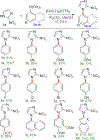Cu-Catalyzed Chan-Evans-Lam Coupling Reactions of 2-Nitroimidazole with Aryl Boronic Acids: An Effort toward New Bioactive Agents against S. pneumoniae
- PMID: 35819995
- PMCID: PMC10184775
- DOI: 10.1002/cbdv.202200327
Cu-Catalyzed Chan-Evans-Lam Coupling Reactions of 2-Nitroimidazole with Aryl Boronic Acids: An Effort toward New Bioactive Agents against S. pneumoniae
Abstract
The coupling of phenylboronic acids with poorly-activated imidazoles is studied as a model system to explore the use of copper-catalyzed Chan-Evans-Lam (CEL) coupling for targeted C-N bond forming reactions. Optimized CEL reaction conditions are reported for four phenanthroline-based ligand systems, where the ligand 4,5-diazafluoren-9-one (dafo, L2) with 1 molar equivalent of potassium carbonate yielded the highest reactivity. The substrate 2-nitroimidazole (also known as azomycin) has documented antimicrobial activity against a range of microbes. Here N-arylation of 2-nitroimidazole with a range of aryl boronic acids has been successfully developed by copper(II)-catalyzed CEL reactions. Azomycin and a range of newly arylated azomycin derivatives were screened against S. pneumoniae, where 1-(4-(benzyloxy)phenyl)-2-nitro-1H-imidazole (3d) was demonstrated to have a minimal inhibition concentration value of 3.3 μg/mL.
Keywords: C−N bond forming reactions; S. pneumoniae; azomycin; copper(II); nitroimidazole.
© 2022 Wiley-VHCA AG, Zurich, Switzerland.
Figures






Similar articles
-
Copper catalyzed N-arylation of amidines with aryl boronic acids and one-pot synthesis of benzimidazoles by a Chan-Lam-Evans N-arylation and C-H activation/C-N bond forming process.Org Lett. 2012 Dec 7;14(23):5980-3. doi: 10.1021/ol3028847. Epub 2012 Nov 14. Org Lett. 2012. PMID: 23151245
-
Recent Developments in Arylation of N-Nucleophiles via Chan-Lam Reaction: Updates from 2012 Onwards.Curr Org Synth. 2022;19(1):16-30. doi: 10.2174/1570179417666210105120706. Curr Org Synth. 2022. PMID: 33402088 Review.
-
Autocatalytic photoredox Chan-Lam coupling of free diaryl sulfoximines with arylboronic acids.Nat Commun. 2021 Feb 10;12(1):932. doi: 10.1038/s41467-021-21156-w. Nat Commun. 2021. PMID: 33568641 Free PMC article.
-
Stereoselective copper-catalyzed Chan-Lam-Evans N-arylation of glucosamines with arylboronic acids at room temperature.Chem Commun (Camb). 2013 Sep 28;49(75):8359-61. doi: 10.1039/c3cc44780d. Chem Commun (Camb). 2013. PMID: 23928939
-
Reductive coupling of nitro compounds with boronic acid derivatives: an overview.RSC Adv. 2023 Nov 13;13(47):33390-33402. doi: 10.1039/d3ra05100e. eCollection 2023 Nov 7. RSC Adv. 2023. PMID: 37964904 Free PMC article. Review.
Cited by
-
Sodium Trifluoroacetate mediated Copper-Catalyzed aza-Michael addition of α,β-unsaturated olefins with aromatic amines.Tetrahedron Lett. 2023 Jun 6;122:154520. doi: 10.1016/j.tetlet.2023.154520. Epub 2023 Apr 28. Tetrahedron Lett. 2023. PMID: 37694227 Free PMC article.
-
Aminoquinoline-Based Tridentate (NNN)-Copper Catalyst for C-N Bond-Forming Reactions from Aniline and Diazo Compounds.Molecules. 2024 Feb 5;29(3):730. doi: 10.3390/molecules29030730. Molecules. 2024. PMID: 38338473 Free PMC article.
-
Pd-, Cu-, and Ni-Catalyzed Reactions: A Comprehensive Review of the Efficient Approaches towards the Synthesis of Antibacterial Molecules.Pharmaceuticals (Basel). 2024 Oct 15;17(10):1370. doi: 10.3390/ph17101370. Pharmaceuticals (Basel). 2024. PMID: 39459010 Free PMC article. Review.
References
-
- Vitaku E, Smith DT, Njardarson JT, ‘Analysis of the Structural Diversity, Substitution Patterns, and Frequency of Nitrogen Heterocycles among U.S. FDA Approved Pharmaceuticals’, J. Med. Chem 2014, 57, 10257–10274. - PubMed
-
- Yellol GS, Donaire A, Yellol JG, Vasylyeva V, Janiak C, Ruiz J, ‘On the Antitumor Properties of Novel Cyclometalated Benzimidazole Ru(II), Ir(III) and Rh(III) Complexes’, Chem. Commun 2013, 49, 11533–11535. - PubMed
-
- Lirag RC, Le HTM, Miljanić OŠ, ‘L-Shaped Benzimidazole Fluorophores: Synthesis, Characterization and Optical Response to Bases, Acids and Anions’, Chem. Commun 2013, 49, 4304–4306. - PubMed
-
- Jillella R, Raju S, Hsiao H-C, Hsu D-S, Chuang S-C, ‘Pd-Catalyzed Redox-Neutral C–N Coupling Reaction of Iminoquinones with Electron-Deficient Alkenes without External Oxidants: Access of Tertiary (E)-Enamines and Application to the Synthesis of Indoles and Quinolin-4-Ones’, Org. Lett 2020, 22, 6252–6256. - PubMed
MeSH terms
Substances
Grants and funding
LinkOut - more resources
Full Text Sources

